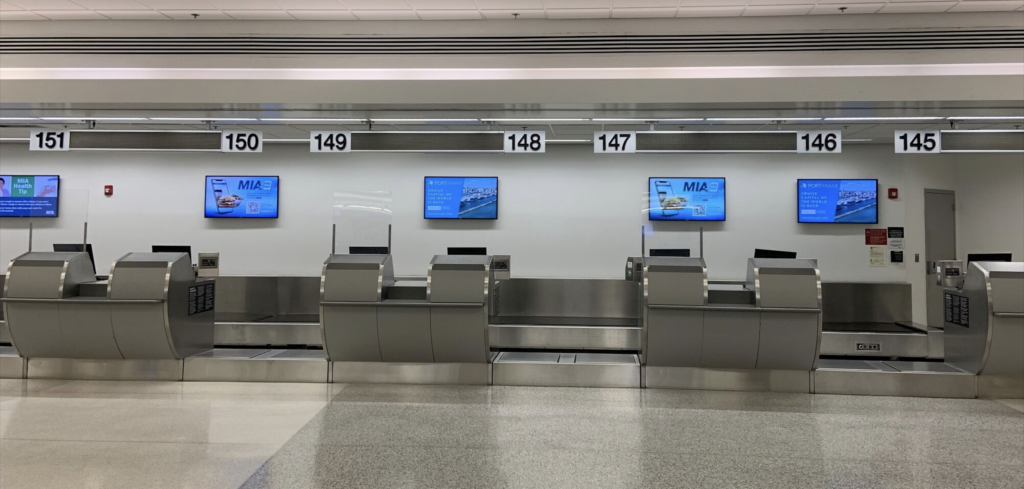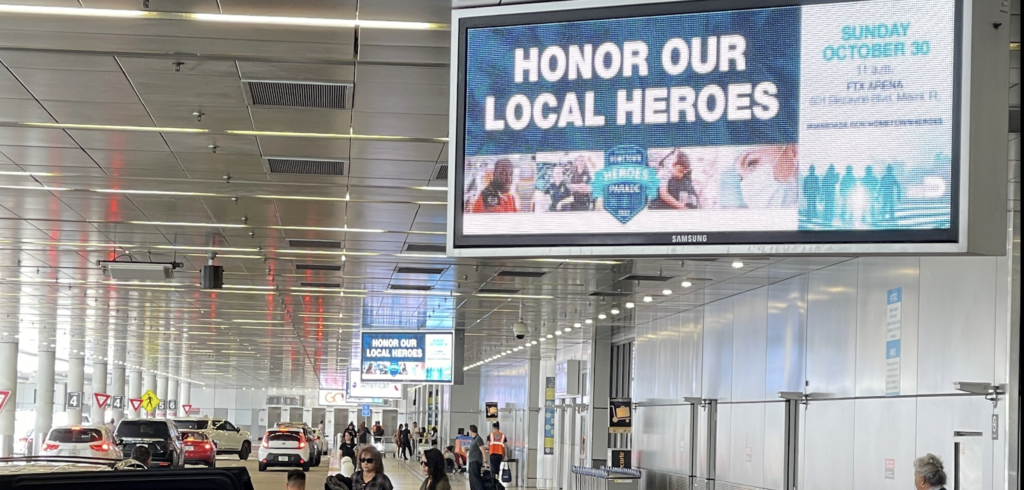Richard Garcia, chief of signage design and wayfinding at Miami International Airport (MIA) in Florida, looks at the most vital features and trends in digital media in passenger terminals, and how airports can best harness the power of digital displays to transform every part of the passenger journey from advertising to accessibility and from sense of place to wayfinding.
What is the importance of digital media to airports – and what key trends have shaped its development?
Digital media plays a very critical role in airports as it enhances operations as well as the passenger experience. It provides real-time information for flights, baggage delivery, gate assignments, security checkpoint queueing wait time, ground transportation, security updates, etc. thereby ensuring a smoother travel process and reducing stress for passengers.
Several trends in digital media have changed the airport experience, creating more efficiency and engagement for the public. Such trends include interactive wayfinding using self-service kiosks and digital signage; real-time information displayed on FIDS, BIDS and GIDS monitors; mobile apps that enable passengers to check in, retrieve boarding passes, navigate terminals and purchase meals, beverages and services; digital beacons that enable location-based services and advertising; social media to help engage customers, provide information and obtain feedback; and digital art installations that can enrich the passenger experience and provide a sense of place.
What are some of the most crucial, and often overlooked, considerations?
Some crucial considerations when implementing digital signage are: choosing hardware that has proven quality and is able to withstand the busy airport environment; implementing security measures that protect the airport network from unauthorized access and cyber threats; and creating infrastructure that meets the demand of future growth. Alongside this, it’s imperative to establish a network that is reliable and capable of supporting real-time content throughout the airport environment. Airports should be sure to manage content for digital displays in a way that is easy to create and edit, user-friendly, ADA-compliant and captivating. It’s also highly important to monitor displays remotely to provide prompt support for any issues and to comply with data privacy policies when collecting customer data.
How has Miami upgraded or improved its use of digital media? Are you able to be flexible with who sees what, where and when?
MIA has made some significant advances in digital media, including the MIA mobile app, which provides passengers with vital information such as real-time flight information, wayfinding, checkpoint wait times, concessions, ground transportation, parking information and local weather. The airport has also launched an interactive chatbot feature on both the MIA mobile app and website that provides detailed, automated responses to customer questions and concerns. Furthermore, MIA now has a smart parking system that guides customers to available parking spaces, assists with finding the location of parked vehicles and provides easy payment transactions. This feature complements the curbside digital displays that show airline locations in the terminal and the self-service kiosks that offer passengers faster options for airline check-in, bag drop and boarding passes.
 Additionally, gate digital displays provide passengers with real-time information on gate assignments, connecting flights, destinations, etc; and the airport’s social media platforms provide customers with real-time information, support and updates. All of this works alongside large-scale, high-definition advertising displays operating with captivating content.
Additionally, gate digital displays provide passengers with real-time information on gate assignments, connecting flights, destinations, etc; and the airport’s social media platforms provide customers with real-time information, support and updates. All of this works alongside large-scale, high-definition advertising displays operating with captivating content.
How essential is creating a ‘wow’ factor or ‘talking point’ in terms of hardware?
Selecting the correct hardware is essential. Large-scale, high-resolution displays generally provide a ‘wow’ factor when rich content is presented. Digital displays used for advertising tend to employ the latest technology and resolution in efforts to captivate an audience and create a ‘talking point’.
How significant is a sense of place in terms of content?
Sense of place is critical to creating an immersive airport experience that engages customers and leaves a positive, lasting impression on visitors to our community. For example, a 200ft-long, curved digital display mounted above a circular exit ramp at MIA’s concourse D international arrivals area is used to showcase iconic local images. The colorful, moving images provide a sense of place for passengers arriving at MIA from foreign destinations. Similar examples include the high-resolution back-wall displays at Delta Air Lines’ check-in area and the digital “towers” in the international departure hall at LAX.
How vital is accessibility? How do you work to ensure messaging can be understood by as wide an audience as possible?
Ensuring that persons with disabilities have equal access to media content is one of our highest priorities at MIA. Closed captioning is utilized on all video screens displaying news and entertainment throughout the terminal. All content for digital displays is designed to comply with ADA standards. The ADA requires a specific font size based on viewing distances to ensure accessibility for those with visual or cognitive disabilities. Color contrast is also considered for better legibility.
What are the top considerations for advertising? How do you get the balance right?
A key consideration with digital advertising is understanding your target audience. The airport environment has diverse customer demographics, interests and behavior, yet certain content may be more relevant and engaging to the majority of your viewers. Delivering a clear message that resonates with your audience is key.
What are the key factors driving the future of digital displays at airports and what new features do you expect to see?
Digital signage at airports will be driven by advances in technology as higher-resolution displays become more economical and reliable. Other influences are interactive experiences, data integration, integration with mobile devices, wayfinding and navigation, engaging content, energy efficiency and sustainability. These factors will shape the future of digital displays at airports, creating a better overall travel experience.
For more about the importance of digital displays at the airport, click here to discover how Minneapolis-St Paul’s Digital Canvas project has transformed the airport’s ability to communicate with passengers, with more than 900 digital displays now controlled through a single CMS, in an exclusive feature first published in the September 2023 edition of Passenger Terminal World magazine


